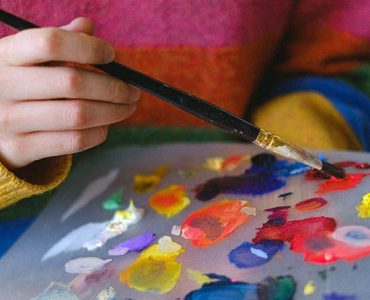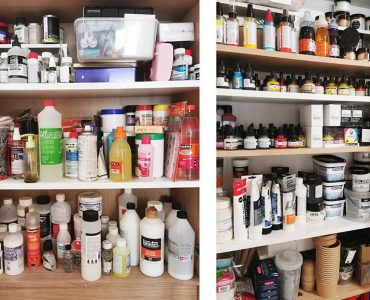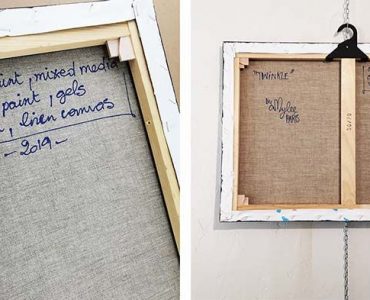Need a palette to make mixing colours easier? Amylee shares her favourite one!

Artists Glass Palette for Colour Mixing
From the wide choice of painters’ palettes, today I’m talking about the glass palette.
Why use a glass palette? How do you use it?
You’d like to know more? Here is an article just for you.
The Artists’ Glass Palette
Among the artist’s palettes sold in fine art shops, you will find rectangular models available in several sizes. These glass palettes are:
- Made from tempered glass with a thickness of 3 mm
- Resistant to solvents and water
- Generally have rounded and reinforced corners for maximum stability (no slipping) and safety
- quite heavy even with smaller sizes, these palettes are only used on a table top
The Palette for your Artist Studio
With a smooth surface, ideal for creating, grinding and mixing colours, the glass palette can be used for different techniques:
- Oil paints
- Acrylic paints
- Gouache paints
- Monotype prints
- Work surface for hobbies (working with modelling clay, and so on)
GREAT TO KNOW : These products are currently available at GreatArt Online or in the art supply shop in London Shoreditch..

TOP TIP: Use a palette knife to work your colour mixtures. Your brushes will thank you over time as they will wear out less quickly.
What type of Glass?
4 colours are frequently used to create a glass palette.
– transparent glass
– white tinted glass
– medium grey tinted glass
– black tinted glass

TOP TIP: The glass palettes, tinted in medium grey, help with colour calibration and gradation. The neutral grey allows for colour adjustment.
How do I Clean a Glass Palette?
I’m sharing with you some top tips to remember that will make cleaning your palette easier.
1. Dry Cleaning
A cutter, scraper or metal spatula with a little elbow grease will remove the dry film of paint from the glass. With oil paint, I recommend adding a little solvent to a cloth to help the paint come off.
2. Wet Cleaning
You will need:
- 1 roll of paper towels
- 1 spray bottle of water (can be replaced by a glass of water)
- 1 glass palette full of dry paint
- 1 metal or plastic spatula
- 1 old rag or paper towel

The recipe to follow:
✔️ Apply 1-2 sheets of paper towel directly to the dry acrylic paint stuck on your glass palette. You could also use old newspapers or rags.

✔️ Using a spray bottle filled with water, and thoroughly moisten the entire surface of the paper towel.

✔️ Leave the wet paper towel on the acrylic paint for 20 minutes, then remove it.
✔️ Under the effect of water, the acrylic paint has wilted, blistered in some places, and will no longer adhere to the glass.

✔️ You can then peel it off with a plastic or metal spatula. The paint comes off in big patches, it’s a treat to clean it all up in one easy motion. Feel free to take an old rag to wipe off the remaining paint.

TOP TIP: With this method, removing the paint is hypnotic and extremely rewarding. The ease of the gesture removes lots of stress. You will see how relaxing a glass palette covered in acrylic paint can be!
4 tips for creating your own glass palette
It is possible to make a glass palette from everyday materials, found at a garage sale or elsewhere. I love recycling! Why not try :
- a simple glass cutting board used in the kitchen. If it is no longer needed and does not have too many patterns, it will do in the studio. I prefer smooth surfaces to rough ones that catch too much and make cleaning difficult.
- A thick glass shelf taken from an old refrigerator. The glass is strong enough and quite large.
- A shelf from a display cabinet for bulky items. The glass on the shelves is thick enough to make a nice palette.
- A glass top for a cabinet. You can find them in IKEA. Glass furniture tops (black, white or grey), they can be a godsend for artists looking for a glass palette.
TOP TIP: The glass from frames or old windows is not strong enough for long-term use as an artist’s palette. Unfortunately, they are breakable with the slightest impact, and their edges are too sharp to handle during cleaning. These types of glass are not suitable for a studio glass palette.


Content provided by Amylee Paris
The passion of Amylee Paris, painter, consultant and author is to share her paintings between galleries, art collectors and her community. Beyond her pictorial skills and her several eBooks available online, Amylee is also recognized as one of the most influential francophone artist-entrepreneurs. She helps beginners or professional artists to optimize their artistic activity.
You can visit her colourful portfolio,follow her on Facebook and Instagram, or find all Amylee’s posts published in GreatArt online Magazineby clicking here!





















Add comment